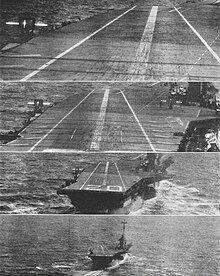Optical Landing System

As optical landing system , an optical system is to support the landing approach on aircraft carriers designated and air bases. The system is also known by the nickname Meatball (dt. Meatball ).
development
The introduction of the approaching aircraft on aircraft carriers was originally from the landing signal officers taken that were teaching the machines using gestures on the correct Landeweg. When the development of carrier aircraft advanced after the Second World War and the machines became faster and faster, the previous system became too imprecise and too slow. In the early 1950s, a British officer therefore developed an optical system based on mirrors that showed the pilot of the approaching aircraft the correct approach angle. The Optical Landing System was invented as Mirror Landing Aid by the British Lieutenant Commander HCN Goodhart ( Royal Navy ).
Layout and function

Mirror-based system
A strong spotlight, dimmed except for a cross-shaped slot, irradiates a mirror of sufficient size horizontally from a certain distance , which is inclined to the vertical at half an angle of the approach path to be displayed. There is a horizontal line of rows of green lights on each side of the mirror. A pilot who glides with sufficient accuracy for landing sees - as if through a window - the virtual image of the light cross of the aperture in the mirror. The targeted position of the cross in the gap between the 2 green lines shows the pilot the position of the aircraft in relation to the desired glide path: If the pilot is too high and too far to the right, the cross appears because it is at a distance "behind the window" , higher than the lines and to the right of the middle of the gap in the lines. Finally, however, the pilot has to orient himself more precisely towards the runway next to the mirror and round out the glide angle towards the horizontal. The mirror can be adjustable for different angles of glide and for easier "catching" of the flyer (only) it can be slightly convex at its edges. The mirror system is hung gyroscopically to compensate for the roll and pitch of the ship.
Lens based system
Since the mirror-based system proved to be too unreliable in some situations, the United States Navy tested a system in the 1960s in which Fresnel lenses took over the projection of the light. Compared to the mirror system, there was a change here that the pilot also saw a red light during an extremely low approach, which prompts him to abort.
See also
Web links
- howstuffworks.com Declaration (Engl.)
Individual evidence
- ↑ Sturtivant, Ray (1990). British Naval Aviation, The Fleet Air Arm, 1917–1990. London: Arm & Armor Press. pp. 161-179. ISBN 0-85368-938-5 .


